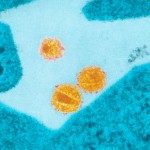Lien vers Pubmed [PMID] – 11799153
J. Virol. 2002 Feb;76(4):1588-99
In vivo adaptation of simian-human immunodeficiency virus (SHIV) clone SHIV(SF33) resulted in the emergence of pathogenic isolate SHIV(SF33A), which caused a rapid and severe CD4(+) T-cell depletion when inoculated into rhesus macaques. Two molecular clones generated by inserting the env V1-to-V5 region amplified from SHIV(SF33A)-infected animals into the parental SHIV(SF33) genome retained a pathogenic phenotype. The gp120 envelope glycoproteins of pathogenic clones SHIV(SF33A2) and SHIV(SF33A5) conferred a threefold increase in viral entry and fusogenicity compared to the parental glycoprotein. Changes in gp120 were also responsible for a higher replication capacity and cytopathicity in primary CD4(+) T-cell cultures. Last, gp120 carried the determinants of SHIV(SF33A) neutralization resistance. Thus, changes in SHIV(SF33A) gp120 produced a set of properties that could account for the pathogenic phenotype observed in vivo. Measurement of antibody binding to SHIV(SF33A) viral particles revealed an increased exposure of the CD4-induced epitope recognized by the 17b monoclonal antibody in a region that was shown to contribute to coreceptor binding. Exposure of this epitope occurred in the absence of CD4 binding, suggesting that the envelope glycoprotein of pathogenic SHIV(SF33A) clones folded in a conformation that was primed for interaction with CXCR4 or for the subsequent step of fusion.
